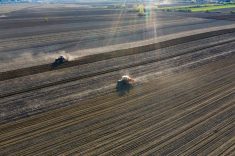Researchers have found potential in sorghum sudangrass — a hybrid of sorghum varieties — as a fungal disease-fighting, soil-enriching grass for cover crops.
Although the research was conducted in Prince Edward Island, some say there may be applications for Western Canada as well — including potential as highly-nutritious cattle feed.
Two Agriculture and Agri-Food Canada scientists — Adam Foster and Harini Aiyer, with the AAFC research farm in Harrington, P.E.I. — wanted to see how eight cover crops would impact fusarium crown and root rot in barley and soybean, two crops targeted by the fungal diseases. They planted them a year prior to barley and soybean.
Read Also

Claas brings 1000 Series SP forage harvesters to Canada
In mid-August, Claas unveiled its new line of Jaguar forage harvesters at an event in Visalia, California, deep in the heart of that state’s dairy region.
Sorghum sudangrass stood out by a large margin, the researchers say. Per an AAFC release, “Alfalfa and brown mustard were good at reducing fusarium crown and root rot in barley and phacelia was good for soybean, but sorghum sudangrass was the best for both barley and soybean.”
This, the researchers say, suggests sorghum may be “recruiting” beneficial microorganisms in the soil microbiome — the collection of beneficial and harmful microorganism communities in the soil — which suppress the development of these diseases.
“Beneficial organisms we observed were fungi like clonostachys, trichoderma and isaria species that may have beneficial anti-fungal and anti-insect activity,” Foster and Aiyer wrote in a joint email.
“(They) were present at higher levels in the soil the year after growing SSG compared to unmanaged fields.”
‘Quite sensitive’
But how would it perform in Western Canada? Kevin Elmy, a Saskatchewan-based agrologist and the mind behind Cover Crops Canada, says the grass tends to grow best in the southern regions of the Prairies.
“We have been playing around with sorghum sudan since 2000,” Elmy said via email.
“It brings a lot of benefits in a mix: biomass, strong root structure, a quick-growing warm-season grass, high plant sugar content.
“Where we use it is in polycrop mixtures, usually mixing with species like Japanese millet, annual clovers, Italian ryegrass or winter triticale, phacelia, and sunflowers.”
It grows well under irrigation, he says.
“With sorghum sudan being grown in irrigation areas with good heat, it can be used as a one-cut system if they can handle or a multiple-cut system. ”
While sorghum sudangrass sports a number of benefits, it has a few characteristics that might give growers cause for pause. For one, the stems can be high-moisture, so drydown can be challenging, especially with the fast regrowth, Elmy says.
“Seed can be costly, production is hampered by cool or dry conditions and when under stress can produce prussic acid toxic to grazing animals.”
Its maturity also tends to be on the late side, he says.
That said, Elmy rates its palatability as “extremely high.” Also, the prussic acid issue can be minimized by leaving stubble where it won’t hurt the grazing cattle, he says.
“It can be grazed, preferably leaving 18 inches of stubble, as that is where issues like prussic acid can accumulate.”
John Griffin, who ranches near the south-central Saskatchewan communities of Central Butte and Bridgeford, says prussic acid in sorghum doesn’t present a risk as long as grazing is done at the right time in the plant’s development.
“If you start grazing that before it gets about knee-height, then there is a risk of prussic acid poisoning,” Griffin says, adding that deer learn quickly to avoid the crop after becoming ill.
Although sorghum sudangrass may be a good crop in mixes, its height can vary dramatically from year to year, Elmy says.
“In 2000 our sorghum sudan grew 14 feet tall. In 2001, it struggled to get above my knees. 2000 was a warm year with good moisture. 2001 was cool and dry. Sorghum sudangrass is quite sensitive to growing conditions.”
Sorghum sudangrass is considered a warm season species, but Elmy doesn’t hold its drought tolerance in high regard, at least on the southern Prairies.
“The drought tolerance referred to in America’s Midwest is based on a ‘drought’ of 12 inches of rain. In areas with three inches of rain, other species should be considered.”
Griffin is a full-on sorghum enthusiast. Although he only planted sorghum sudangrass itself once under irrigation, he was immediately impressed with how well cattle digested the grass.
“The sorghum sudan that we grew was a 55-day maturity product and that variety was a BMR [Brown Midrib sorghum] type, which we really liked. It has reduced lignin content, which makes for greater digestibility in a ruminant.”
Today Griffin eschews sorghum Sudan in favour of a male sterile cultivar of the plant that does not produce male flowers and subsequently no seed.
”All the photosynthate goes into the cells of the plant, which increases sugar content and digestible carbohydrates,” he says.
“And really, that’s what you want for a ruminant. You don’t really want a lot of grain because the risk of acidosis is ever-present.”
Griffin’s sorghum seems made for cattle. Wildlife in his area, such as deer, give it a pass, he says.
Mammals aren’t the only ones that turn up their nose at sorghum. Grasshoppers also give it a wide berth, Griffin says.
Sorghum tends to play dead under heat stress but can come roaring back with some moisture, he said.
“Sorghum has this unique ability that, because it’s a C4 crop, it can sustain high degrees of heat — a lot better than corn, even — and it’ll just sit there.
“You think it’s dead or it’s not going to grow or whatever, but it doesn’t turn brown and look like a dead plant like a barley or a C3 crop would, but it’ll just sit there and wait, and then when it gets rain, it grows.
(Both crops and weeds in Western Canada are divided into C3 and C4 categories based on the way they use carbon dioxide.)
“It still needs water like any other crop does but it has the ability to sustain periods of drought and not kill it, where a lot of our C3 crops just die or they go to early maturity and they’re just stunted.”
‘Everything got better’
Although mainly focused on the feeding benefits of sorghum, Griffin is well aware of its impact on his soil fertility.
“This year we didn’t have to add any fertilizer to our sorghum crop and I would suspect it’s at least six tonnes of dry matter per acre.
“Keeping the cattle on the field, it just creates this nutrient cycle. In ’21 our soil organic matter was 2.2 per cent and May of this year it was 5.1 per cent organic matter. So that made a big difference in terms of sequestering carbon into the soil. Our pH dropped from 7.5 to 6.6. Our mineralizable nitrogen increased by 90 pounds.”
His phosphorus levels were also higher, despite living in an area where P is in short supply.
“Potassium was higher, sulphur content of the soil was higher, copper was higher. Everything got better. By having the cattle on the landscape and not having to use synthetic fertilizers, the feeding method that we’re employing makes a big difference on the bottom line as well.”
















